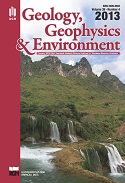Suitability study of using birch and willow trees in phytoremediation of acidic waste settlers
Main Article Content
Keywords
settler, acidic wastes, bioaccumulation, heavy metals, phytoremediation
Abstract
Research addresses the issue of assessing the possibility of using birch and willow trees in phytoremediation of acidic waste settlers. In order to determine the suitability of these trees to bioaccumulate metals it was crucial to first characterized the physico-chemical parameters of the waste. Both waste and leaves samples were analyzed with respect to heavy metals concentration using microwave digestion (conc. HNO3 ) procedure followed by AAS analyzes. Moreover, the mobility of contaminants from waste was studied using aqueous leaching test as well as sequential extraction procedures. Investigated waste is very inhomogeneous and is characterized with diversity of pH values within sampling points (2.9–7.0) as well as with high concentration of SO4 2− anions (1203–1301 mg/dm3 ), Fe (11–19%) and Zn (64–172 mg/kg). Ability to accumulate metals in birch and willow leaves is high. In birch leaves Zn was accumulated up to toxic level of 431 mg/kg, Mn up to 790 mg/kg, Cu up to 9 mg/kg, Pb up to 21 mg/kg. In willow leaves Zn concentration were found to be even higher and reached 679 mg/kg. Concentrations of remaining metals in willow leaves were as follows: Mn up to 173 mg/kg, Cu up to 17 mg/kg and Pb up to 10 mg/kg. Research results confirmed that both birch and willow trees growing on settlers have high tolerance to the adverse living conditions caused by metal stress and low pH of the foundation. These trees can be used for the purpose of phytoremediation of investigated waste settlers.
Downloads
References
Bettiol C., Stievano L., Delfini F. & Argese E., 2008. Evaluation of microwave assisted acids extraction procedures for the determination of metal content and potential bioavailability in sediments. Applied Geochemistry, 23, 1140-1151.
Chaney R., Malik M., Li Y.M., Brown S.L., Brewer E.P., Angle J.S. & Baker A.J.M., 1998. Phytoremediation of soil metals. Current Options in Biotechnology, 8, 279-284.
Dickinson N.M., 2000. Trees as environmental sentinels. Biologist, 47, 211-215.
Dold B., 2003. Speciation of the most soluble phases in a sequential extraction procedure adapter for geochemical studies of copper sulfide mine waste. Journal of Geochemical Exploration, 80, 55-68.
Kabata-Pendias A. & Pendias H., 1999. Biochemia pierwiastków śladowych. Wydawnictwo Naukowe PWN, Warszawa.
Kacprzak M., 2007. Wspomaganie procesów remediacji gleb zdegradowanych. Monografie - Politechnika Częstochowska 128, Wydawnictwo Politechniki Częstochowskiej, Częstochowa.
Pulford I.D. & Watson C., 2003. Phytoremediation of heavy metal contaminated land by trees a review. Environment International, 29, 529-540.
Szarek-Łukaszewska G., Ryszka P. & Zarszyka-Ryszka M., 2009. Rekultywacja odpadów Zn/Pb - metody ekologiczne - eksperyment terenowy, [in:] Ozonek J. & Pawłowski A. (red.), Polska inżynieria środowiska pięć lat po wstąpieniu do Unii Europejskiej, 2, Komitet Inżynierii Środowiska PAN, Lublin, 219-223.
Tessier A., Campbell P.G.C. & Bisson M., 1979. Sequential extraction procedure for speciation of particulate trace metals. Analytical Chemistry, 51, 844-851.
Tordoff G.M., Backer A.J.M. & Willos A.J., 2000. Current approaches to the revegetation and reclamation of metaliferous mine wastes. Chemosphere, 41, 219-228.
Urbańska K.M., Webb N.R. & Edwaerd P.J., 1997. Restoration ecology and sustainable development. Cambridge University Press.


